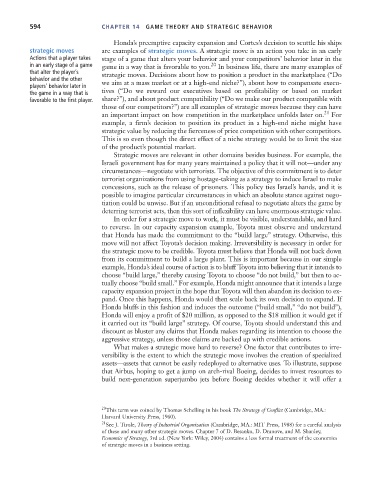Page 620 - Microeconomics, Fourth Edition
P. 620
c14gametheoryandstrategicbehavior.qxd 8/6/10 8:22 AM Page 594
594 CHAPTER 14 GAME THEORY AND STRATEGIC BEHAVIOR
Honda’s preemptive capacity expansion and Cortes’s decision to scuttle his ships
strategic moves are examples of strategic moves. A strategic move is an action you take in an early
Actions that a player takes stage of a game that alters your behavior and your competitors’ behavior later in the
in an early stage of a game game in a way that is favorable to you. 20 In business life, there are many examples of
that alter the player’s strategic moves. Decisions about how to position a product in the marketplace (“Do
behavior and the other we aim at a mass market or at a high-end niche?”), about how to compensate execu-
players’ behavior later in
the game in a way that is tives (“Do we reward our executives based on profitability or based on market
favorable to the first player. share?”), and about product compatibility (“Do we make our product compatible with
those of our competitors?”) are all examples of strategic moves because they can have
an important impact on how competition in the marketplace unfolds later on. 21 For
example, a firm’s decision to position its product in a high-end niche might have
strategic value by reducing the fierceness of price competition with other competitors.
This is so even though the direct effect of a niche strategy would be to limit the size
of the product’s potential market.
Strategic moves are relevant in other domains besides business. For example, the
Israeli government has for many years maintained a policy that it will not—under any
circumstances—negotiate with terrorists. The objective of this commitment is to deter
terrorist organizations from using hostage-taking as a strategy to induce Israel to make
concessions, such as the release of prisoners. This policy ties Israel’s hands, and it is
possible to imagine particular circumstances in which an absolute stance against nego-
tiation could be unwise. But if an unconditional refusal to negotiate alters the game by
deterring terrorist acts, then this sort of inflexibility can have enormous strategic value.
In order for a strategic move to work, it must be visible, understandable, and hard
to reverse. In our capacity expansion example, Toyota must observe and understand
that Honda has made the commitment to the “build large” strategy. Otherwise, this
move will not affect Toyota’s decision making. Irreversibility is necessary in order for
the strategic move to be credible. Toyota must believe that Honda will not back down
from its commitment to build a large plant. This is important because in our simple
example, Honda’s ideal course of action is to bluff Toyota into believing that it intends to
choose “build large,” thereby causing Toyota to choose “do not build,” but then to ac-
tually choose “build small.” For example, Honda might announce that it intends a large
capacity expansion project in the hope that Toyota will then abandon its decision to ex-
pand. Once this happens, Honda would then scale back its own decision to expand. If
Honda bluffs in this fashion and induces the outcome (“build small,” “do not build”),
Honda will enjoy a profit of $20 million, as opposed to the $18 million it would get if
it carried out its “build large” strategy. Of course, Toyota should understand this and
discount as bluster any claims that Honda makes regarding its intention to choose the
aggressive strategy, unless those claims are backed up with credible actions.
What makes a strategic move hard to reverse? One factor that contributes to irre-
versibility is the extent to which the strategic move involves the creation of specialized
assets—assets that cannot be easily redeployed to alternative uses. To illustrate, suppose
that Airbus, hoping to get a jump on arch-rival Boeing, decides to invest resources to
build next-generation superjumbo jets before Boeing decides whether it will offer a
20
This term was coined by Thomas Schelling in his book The Strategy of Conflict (Cambridge, MA.:
Harvard University Press, 1960).
21
See J. Tirole, Theory of Industrial Organization (Cambridge, MA.: MIT Press, 1988) for a careful analysis
of these and many other strategic moves. Chapter 7 of D. Besanko, D. Dranove, and M. Shanley,
Economics of Strategy, 3rd ed. (New York: Wiley, 2004) contains a less formal treatment of the economics
of strategic moves in a business setting.

